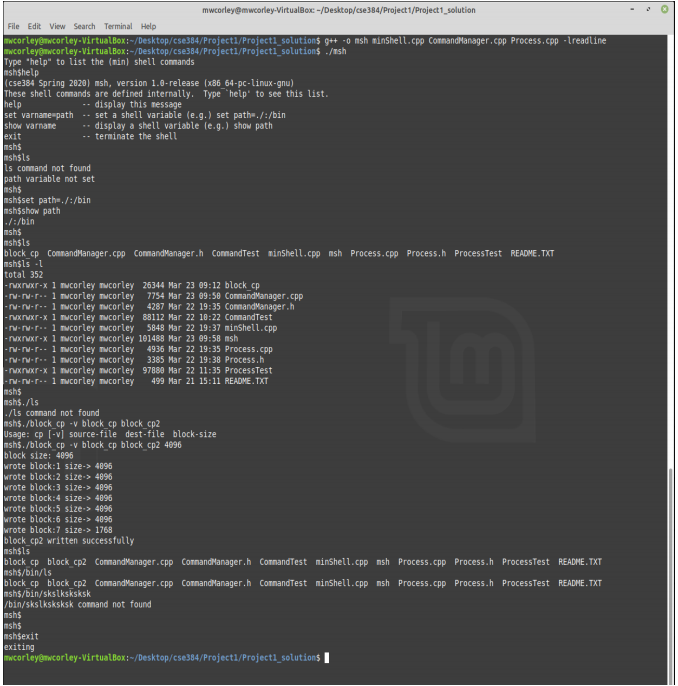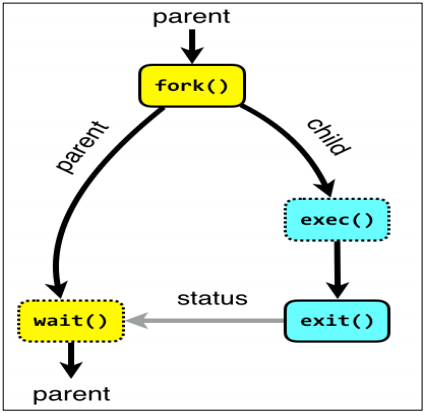Project # 1: Build a minimal shell (minShell): due Friday April 3rd .
We have seen that a Unix shell (like BASH) is a sophisticated command-interpreter and scripting language that provides a powerful user interface to the operating system. In the most basic sense, a shell is a program that executes other programs.
In this project you will build a minimalist shell that supports the following requirements:
a. Shell (built-in) commands: setting/showing shell variables: support shell built-in command: set/show
i. msh$ set path=./:/binii. msh$ show path
./:/bin
iii. msh$ set name=Mike
msh$ show name
Mike
• Note: You will have to parse commands entered by the user to determine what command and arguments to properly run in your shell.• Your shell will need to make use of at least two system calls
o fork – creates a new (child) process by duplicating the parent process (the minShell process) -- use “man fork” for the man pageo execv - loads (overlays) an existing process with a new process image -- use “man execv”. Note: there is a family of exec functions, but we will use execv for this project
iv. msh$ ./block_cp (relative path), should run local programs (whether or not path is set)
That’s it! When your shell supports requirements: 1. 2. 3a and 3b, then submit the code and the output as separate documents in Blackboard under the Project 1 assignment. Please upload your code with the name “MinShellCode”, and the output with name “MinShellOutput”.
Note: It is up to you to generate your output/screenshots so that it clearly demonstrates you’ve met requirements 3a. and 3b. If you don’t clearly demonstrate you meet 3a. and 3b. you may not get full credit.
Here is an example output from instructor solution:

Helper code: (Process package, CommandManager package, and minShell.cpp executive)
minShell.cpp (executive): implements minShell (msh) using the services of Process package and CommandManager package
***Note:*** I’ve given lots of help. All you should really need do to complete Project 1 is implement the two functions: DoProcessExternalCommand, DoProcessBuiltInCommand in minShell.cpp, which handle the (built-ins) set and show shell variables, and executing external programs respectively. View the test stubs in Process.cpp and Command Manager.cpp to see how you might implement these functions.
Background and thoughts and Starting
a. Reading input from the user means the user types a command line and presses enter/return
a. Parsing the command means to extracting the parts and determine what actions(s) to take. i.e. set/get shell variables or run/execute an external command. For example:
i. msh$ set path=/usr/local/sbin:/usr/local/bin:/usr/sbin:/usr/binii. msh$ ls -l
3. Executing the parsed command requires the creation of a new (child) process. Creating a new process is performed with the fork system call, followed by an exec system call to load the process image specified in the command
a. When a shell executes a command, it first creates a copy of itself (the child process by calling fork). It then calls exec in the child process to load/run the command by loading specified program image into (overlaying) child process with the specified program image (See Figure 1 below for an illustration of the process).
i. Please read the following Lecture from USNA to begin getting a grasp on the concept:
https://www.usna.edu/Users/cs/aviv/classes/ic221/s16/lec/14/lec.html
• Note: I intend to give a significant amount of helper code. That will be posted soon, and a notification will be sent via piazza
This is the basic idea:

Figure 1: Command Execution
Image source: http://www.it.uu.se/education/course/homepage/os/vt18/module-2/process-management/
2020-03-25